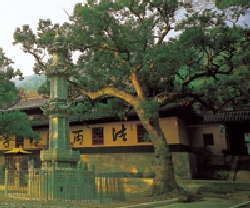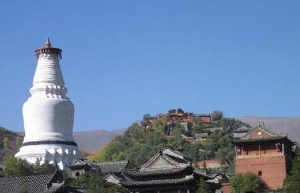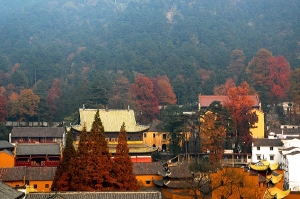Four sacred buddhist mountains in China
April 15 2006
In the 1st century A.D. merchants returning from India via the Silk Route began the introduction of Buddhism into China. Over the next few centuries’ adventurous Chinese pilgrims traveled to India to visit the sacred places of the Buddha’s life. As the Chinese buddhists monks favored quiet mountains and deep forests for their meditative practices, small hermitages and later great monastic complexes sprung up at many peaks and over the centuries the Buddhists began to regard four peaks as having primary sanctity:

Pu Tuo Shan, Buddhist mountain of the east, Zhejiang province, 284 meters. Sacred to Kuan-Yin, the Bodhisattva of Compassion.

Wu Tai Shan, Buddhist mountain of the north, Shanxi province, 3061 meters. Sacred to Manjushri, the Bodhisattva of Wisdom.

Emei Shan, Buddhist mountain of the west, Sichuan province, 3099 meters. Sacred to Samantabhadra, the Bodhisattva of Benevolent Action.

Jiu Hua Shan, Buddhist mountain of the south, Anhui province, 1341 meters. Sacred to Kshitigarbha, the Bodhisattva of Salvation.
Each of the Buddhist sacred mountains is considered to be the dwelling place of a Bodhisattva. These particular Bodhisattvas are mythological spiritual beings that have dedicated themselves to the service of assisting all sentient creatures in the transcendence of worldly suffering and the attainment of enlightenment. These Buddhist mountains became the primary pilgrimage destinations of both China’s masses and also the ruling elite. Over many centuries the monastic centers developed into great centers of scholarship, art and philosophy, with hundreds of temples and thousands of monks and nuns. This extraordinary way of life continued unbroken until the Cultural Revolution(1967-77) [[A period of widespread social and political upheavalin in the People’s Republic of China; the nation-wide chaos and economic disarray engulfed much of Chinese society]] Since the 1980’s the Communist apparatus has taken less a destructive approach to religious culture and both Buddhism and Taoism are reviving
All four mountains are in beautiful areas, homes for rare and endangered birds, animals and plant species. Yet because they are sacred, paradoxically they suffer from the ravages of tourism and pilgrimage as well as logging and development.
– Source : Arcworld
– Related articles:
- Wu Tai Shan: a holy place of buddhism unity
- Putuo Shan: a paradise of buddha in the middle of the sea
- Emei Shan : holy buddhist mountain in the west of China
- Jiu Hua Shan: the past and the present
- 大乘佛教圣地峨眉山
- 普陀山如何与佛教结缘(图)
- 五台山为什么被尊称为“佛国圣地”?




